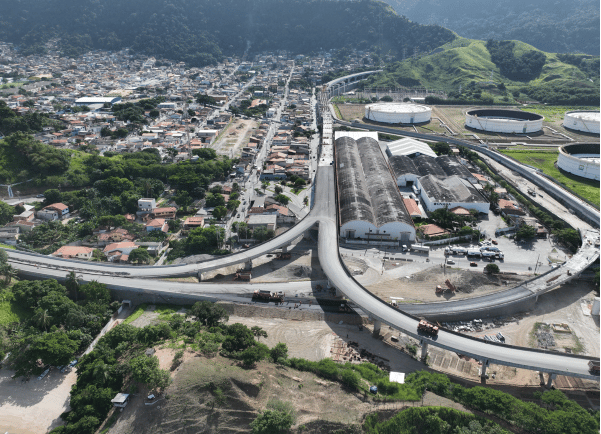A Complete Guide to Brazil’s Most Advanced Mountain Crossing
A Complete Guide to Brazil’s Most Advanced Mountain Crossing. The New Tamoios Highway (SP-099), known as the “Nova Serra” segment, is one of the most significant road infrastructure projects connecting Brazil’s Paraíba Valley to the Northern Coast of São Paulo. Designed to improve safety, expand capacity, and modernize the crossing of the Serra do Mar mountain range, the project includes highway duplication, long tunnels, and a system of viaducts engineered to minimize environmental and operational impacts.
FACES AND FACTS
Unveiled Brazil
11/22/20255 min read


New Tamoios Highway (SP-099): A Complete Guide to Brazil’s Most Advanced Mountain Crossing
Introduction
The New Tamoios Highway (SP-099), known as the “Nova Serra” segment, is one of the most significant road infrastructure projects connecting Brazil’s Paraíba Valley to the Northern Coast of São Paulo. Designed to improve safety, expand capacity, and modernize the crossing of the Serra do Mar mountain range, the project includes highway duplication, long tunnels, and a system of viaducts engineered to minimize environmental and operational impacts.
Below is a full overview of the route’s history, the limitations of the old highway, the need for a new mountain crossing, construction timeline, tunnel engineering, costs, financing, technologies used, the Public-Private Partnership (PPP), and the main benefits already observed. (Source: Concessionária Tamoios)
1. Historical Background and the Old Highway
The connection between the highlands (São José dos Campos/Paraibuna) and the coastal city of Caraguatatuba has always been essential for tourism, regional mobility, and local logistics. The original Tamoios Highway (SP-099) dates back decades and has undergone paving, realignments, and emergency repairs due to landslides, erosion, and flooding.
Until the 2010s, the mountain stretch still had:
single lanes in several segments
narrow, winding curves
steep drops
low visibility during fog and rain
chronic congestion during holidays
These limitations made the route slow, unsafe, and vulnerable to climate-related disruptions. (Source: Wikipedia)
2. Why the New Tamoios Was Necessary
Several structural and safety factors justified the construction of the New Tamoios Highway:
• Road safety
The old design—tight curves, single lanes, and unstable slopes—was associated with frequent accidents.
• Traffic capacity
Holiday congestion could create hours-long delays. Duplication and tunnels were essential for stability and fluidity.
• Climate resilience
By moving the highway inside tunnels and onto modern viaducts, the new design prevents shutdowns caused by landslides.
• Regional development
A faster and more reliable route strengthens tourism and stimulates new investments along the Northern Coast.
Environmental studies also concluded that tunnels would produce far less deforestation than open-air cuts through the Serra do Mar. (Source: Concessionária Tamoios)
3. Construction Timeline
Start of construction: December 2015
Execution period: 2016–2021, with simultaneous work fronts
Official opening: March 26, 2022
Total length of new mountain segment: approx. 22 km
The schedule included excavation, tunnel lining, viaduct construction, drainage systems, and final paving. (Source: Concessionária Tamoios)
4. Tunnels — The Engineering Highlight of the Project
The New Tamoios is today considered one of Brazil’s most advanced tunnel systems.
Key features:
Total tunnel length: over 12 km across multiple structures
Includes one continuous tunnel of 5.55 km, the longest highway tunnel in Brazil
Integrated with 24 major structures: tunnels, bridges, and viaducts (Source: Exame)
Engineering methods
The project combined:
traditional excavation
controlled blasting
use of tunnel boring machinery (depending on geology)
rock reinforcement, anchors, and injections
robust drainage systems
Inside the tunnels:
smart ventilation systems
automated fire detection
CCTV with real-time monitoring
emergency telephones
structural health monitoring sensors
These technologies allow safe operation even during intense rainfall, a common issue in the Serra do Mar. (Source: Cimento Itambé)
5. Cost and Financing Structure
Cost estimates vary depending on the project scope considered:
• Serra segment investments
Approx. R$ 2.9 to R$ 3.1 billion, based on the final values at the 2022 inauguration. (Source: Concessionária Tamoios)
• Total PPP investment
Including additional stretches and complementary works, total contracted investment reached R$ 3.7–3.9 billion over a 30-year concession period. (Source: BNDES)
Costs include:
tunnel excavation and lining
viaducts and bridges
slope stabilization
environmental mitigation
highway technology systems
(Source: Band Notícias)
6. Concession and PPP Model
The project operates under a Public-Private Partnership (PPP) in which the concessionaire—Concessionária Tamoios—conducts construction, maintenance, and operation for the duration of the contract.
The PPP includes:
revenue from tolls
public payments (when applicable)
risk allocation mechanisms
long-term governance contracts
The BNDES supported financing and auction structuring. The PPP model ensured modern engineering standards, operational excellence, and continuous monitoring under state regulation. (Source: BNDES)
7. Advanced Technology and Engineering Solutions
The New Tamoios Highway incorporated high-end technologies, such as:
• Excavation and tunnel lining technology
Traditional drilling, blasting, and shotcrete; segmental lining in deeper sections.
• Intelligent transportation systems (ITS)
incident detection
automatic signage
tunnel ventilation control
central command center
• Environmental solutions
minimized forest clearing
viaducts preserving rivers and wildlife corridors
sediment control programs
continuous ecological monitoring
• Free-flow tolling
The new southern bypass includes infrastructure for barrier-less electronic tolling, reducing congestion at toll plazas. (Source: Exame)
8. Benefits Already Observed
• Faster travel times
Government sources estimate travel time cut by up to 50% on the mountain crossing. (Source: Poder360)
• Improved safety
Duplicated lanes, modern lighting, and 24/7 monitoring reduce collision risks.
• Climate resilience
Long tunnels and elevated structures prevent closures during landslides or heavy rain.
In 2023, the new highway was essential for maintaining access to the Northern Coast during severe storms. (Source: Concessionária Tamoios)
• Economic and tourism impact
More tourists, improved hotel occupancy, better logistics for businesses, and regional job creation. (Source: Exame)
9. Social and Environmental Considerations
Major projects in the Serra do Mar require strict environmental governance. The New Tamoios included:
full Environmental Impact Assessments (EIA/RIMA)
reduced vegetation removal through tunnel-first design
continuous wildlife, water, and soil monitoring
noise, sedimentation, and erosion control programs
Despite mitigation measures, some environmental groups express concerns about cumulative ecological effects—an ongoing topic requiring long-term monitoring. (Source: Concessionária Tamoios)
10. Engineering Lessons and Legacy
The New Tamoios Highway became an engineering benchmark in Brazil due to:
integration of geotechnical, environmental, and operational design
Brazil’s longest highway tunnel
innovative PPP and financing structure
advanced safety and mobility systems
Its legacy sets new standards for high-complexity mountain highway projects in Latin America. (Source: Cimento Itambé)
Conclusion
The New Tamoios Highway (SP-099) is a milestone in Brazilian infrastructure, combining large-scale engineering, environmental planning, and a modern PPP model. With nearly R$ 3 billion invested in the mountain segment alone, the project now provides a faster, safer, and more resilient connection between the Paraíba Valley and the Northern Coast of São Paulo.
Here is the full translation into English using advanced SEO rules, preserving formatting and academic tone:
Bibliography (APA Format)
Agência Reguladora de Serviços Públicos do Estado de São Paulo (ARTESP). (2022). Concession Bid Notice – Tamoios Highway Lot (draft and technical annexes). Government of the State of São Paulo. https://www.parceria.sp.gov.br
Almeida, E. de L. (2016). Environmental impact assessment of the duplication of the Tamoios Highway — Plateau Section (Master’s thesis). Universidade Nove de Julho (UNINOVE). https://bibliotecatede.uninove.br
Banco Nacional de Desenvolvimento Econômico e Social (BNDES). (2021). Support for auctions and concessions – Request for financial support for the Tamoios Highway PPP. https://www.bndes.gov.br
CETESB – Environmental Company of the State of São Paulo. (2013). Technical report on the EIA/RIMA for the duplication and tunnel construction of the Tamoios Highway (SP-099), Serra Section. https://cetesb.sp.gov.br
Concessionária Tamoios. (2022–2024). Environmental reports, addenda, technical documents, and construction updates. https://www.concessionariatamoios.com.br
Government of the State of São Paulo / Parcerias SP. (2014). Sponsored Concession Contract for the Tamoios Highway (PPP), including performance annexes, payment structure, and risk matrix. https://www.parcerias.sp.gov.br
Instituto Brasileiro do Meio Ambiente e dos Recursos Naturais Renováveis (IBAMA). (2013). EIA/RIMA – Duplication and Bypass Construction of the Tamoios Highway (Serra and Plateau Sections): Environmental studies made available for public hearings. https://www.ibama.gov.br
News outlets and press. (2022–2024). Reports on construction costs, inauguration, and scheduling of the New Tamoios: Exame, Poder360, Band News. (Consult specific URLs as needed.)
Sociedade Brasileira de Geologia de Engenharia (SBGE). (2018). Proceedings of the Brazilian Congress of Engineering Geology – technical studies on geotechnics, tunnels, and excavation methods used in the New Tamoios. https://www.abge.org.br
